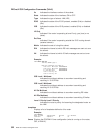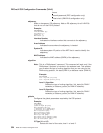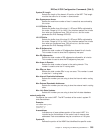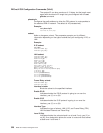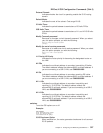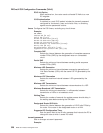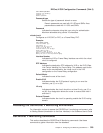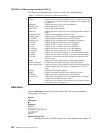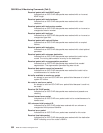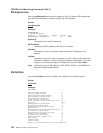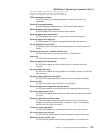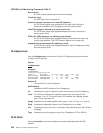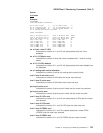
The monitoring commands either display or modify the volatile database.
Table 61. OSI/DECnet V Monitoring Commands Summary
Command Function
? (Help) Displays all the commands available for this command level or lists
the options for specific commands (if available). See “Getting Help”
on page xxvi.
Addresses Displays the router’s NET and area addresses.
Change Metric Modifies the cost of a circuit.
CLNP-Stats Displays OSI CLNP statistics.
DNAV-info Displays the DNAV Level1 and Level2 routing algorithm currently in
effect.
Designated-router Displays the designated router for the LAN.
ES-adjacencies Displays all the ES adjacencies in the adjacency database.
ES-IS-Stats Displays statistics associated with the ESIS protocol.
IS-adjacencies Displays all the IS adjacencies in the adjacency database.
IS-IS-Stats Displays statistics associated with the ISIS protocol.
L1-routes Displays all the L1 routes in the Level 1 database.
L2-route Displays all the L2 routes in the Level 2 database.
L1-summary Displays a summary of the level 1 link state database.
L2-summary Displays a summary of the level 2 link state database.
L1-update Displays the information contained in L1 link state update packet.
L2-update Displays the information contained in L2 link state update packet.
Ping-1139 Causes the router to send an echo request to a destination and
wait for a reply.
Route Displays the route a packet takes to a specified destination.
Send echo packet Encodes an echo request message in the CLNP packet.
Show routing circuits Displays the state of user-defined routing circuits for the specified
interface. Applies when the router is configured as a DEC-style
router.
Subnets Displays all user-defined subnets.
Toggle Enables or disables the NSAP alias substitution function.
Traceroute Displays the route a packet travels to its destination.
Virtual-circuits Displays all user-defined virtual circuits. Applies when the router is
configured as an IBM 2210-style router.
Exit Returns you to the previous command level. See “Exiting a Lower
Level Environment” on page xxvii.
Addresses
Use the addresses command to list the router’s NET and the area addresses
configured for this router.
Syntax:
addresses
Example:
addresses
Network Entity Title:
4700-0500-01 000-9310-04F0
Area Addresses:
4700-0500-01
4900-02
Network Entity Title
Identifies the router. The NET consists of an area address and a system ID.
OSI/DECnet V Monitoring Commands (Talk 5)
330
MRS V3.2 Protocol Config Ref Vol 2



